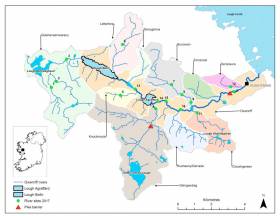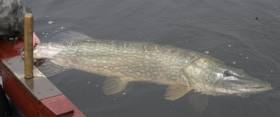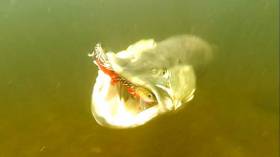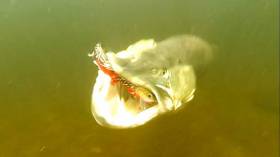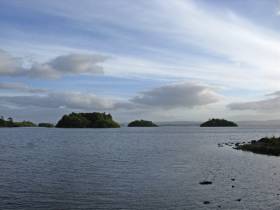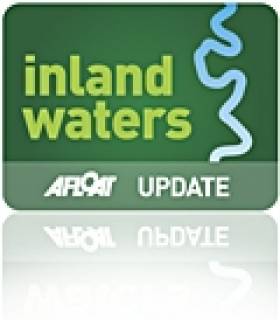Displaying items by tag: Lough Corrib
Plan Published For Recovery Of Salmon & Trout Stocks In Owenriff Catchment
#Angling - Inland Fisheries Ireland has published its 2017 fish stock survey for the Owenriff catchment as well as its rehabilitation plan for the system to promote the recovery of brown trout and salmon in its lakes and rivers.
The Fish Stock Survey — which was conducted in the summer of 2017 and forms the basis for the Rehabilitation Plan — deduces that the introduction of pike into the catchment has been the significant factor in the declining fish stocks.
“As there are little or no major anthropogenic pressures in the catchment to cause the decline in fish stocks, it is reasonable to infer that the introduction of pike and their subsequent range expansion in the Owenriff catchment (with impacts of competition for food and space and predation on resident and migratory fish) is the main factor causing the decline of brown trout and salmon in the Owenriff catchment. Research from Europe and North America supports this finding,” the reports states.
Anthropogenic pressures include human-induced factors such as urban growth, deleterious discharges, farming activities and introduction of alien species.
Although pike were captured for the first time by IFI staff in 2009 in two lakes in the catchment (Loughs Bofin and Agraffard) and efforts were made by IFI staff to remove the pike from the system, they did not show up in two catchment-wide surveys in 1997 and 2007 and were only officially recorded in a survey for the first time in 2015.
However, the latest report, from the 2017 survey, confirms that pike are present all over the Owenriff catchment “in areas where they can freely gain access and in some areas where they cannot naturally gain access.”
Welcoming the publication of the two reports, Minister Sean Kyne TD said: “We have acted swiftly since the interim results of this survey became known. In late January, I announced that Inland Fisheries Ireland is to commence fish stock management operations on the Owenriff catchment to protect and restore trout stocks which have been impacted by recent introductions of pike to the catchment.
“The consequences of not taking wider remedial action on the basis of these survey results would lead to further decline in ecological biodiversity in the catchment, so I very much welcome the publication by IFI of the Owenriff Fish Population Rehabilitation Plan 2018.”
The minister continued: “The purpose of the plan is to develop a fisheries rehabilitation project that can be undertaken on the catchment to promote the recovery of the brown trout (both resident and migratory Corrib) and salmon populations in both lakes and rivers. It will take time and will be costly, but we are already underway with this very constructive and positive roadmap.”
With stock management actions having already commenced, the success of the broader rehabilitation project will depend on applying the correct tools to rehabilitate the brown trout and salmon populations in the Owenriff catchment.
These include fisheries enhancement works in selected sub-catchments to favour brown trout and salmon; genetic restoration; removing the problem (pike control); reducing anthropogenic impacts in the catchment; public awareness (especially in relation to the impacts of the introductions of species not indigenous to an area); interagency co-ordination; climate change mitigation; and any other necessary measures.
The Owenriff catchment is located on the north-western end of the Lough Corrib catchment, and the main Owenriff River drains into Lough Corrib Upper downstream of Oughterard, Co Galway. The Lough Corrib catchment itself is the largest and most important wild salmonid catchment in Ireland, and Lough Corrib is considered the premier wild brown trout fishery in Ireland.
The Owenriff rehabilitation plan and 2017 fish stock survey can both be downloaded from the IFI website. Afloat.ie also has more on IFI's stock management plan for Ireland's trout waters in 2018.
Fish Stock Management Plan Launched For Owenriff Catchment
#Angling - Sean Kyne, Minister of State with responsibility for the inland fisheries sector, has announced that Inland Fisheries Ireland will shortly commence fish stock management operations on the Owenriff catchment near Oughterard in Co Galway.
The measures to protect and restore trout stocks, which have been impacted by recent introductions of pike to the catchment, were promised last November upon the development by IFI of a specific stock management plan.
“The Owenriff catchment is one of the most important spawning and nursery tributaries of Lough Corrib, our most renowned wild trout fishery,” said Minister Kyne as he made the announcement today (Monday 29 January).
“Previous scientific studies have shown it contributed 15% of the wild trout found in Lough Corrib, and each year thousands of wild trout and salmon migrate upstream into the Owenriff to spawn.
“I am committed to protecting and rehabilitating the system and welcome IFI’s stock management plan which I have asked to be implemented immediately.”
IFI will be commencing a focused and intensive effort aimed at reducing the numbers of pike in the Owenriff catchment over the coming year.
While pike cannot be completely eradicated, the project will reduce numbers to a level where they are not impacting significantly on salmonid stocks.
It is expected that ongoing maintenance operations will be required in future years to help maintain the trout population.
Minister Kyne also emphasised that, in tandem with the stock management plan, IFI is also preparing an Owenriff Fish Population Rehabilitation Plan which aims to ensure trout stocks and habitats are restored and protected, thereby providing the best opportunities for a successful trout population. The plan will be available shortly.
Survey results are currently being compiled and will be available from the IFI website. Further information on the stock management plan is available HERE.
Minister Welcomes Stock Management Plan & Survey For Lough Corrib Tributary
#Angling - Sean Kyne, Minister with responsibility for Inland Fisheries, has welcomed the development by Inland Fisheries Ireland (IFI) of a specific stock management plan for Galway’s Owenriff system aimed at removing pike from the system as a significant step forward.
Stock management operations are normally commenced in February each year and the Owenriff plan will be implemented for 2018.
Minister Kyne said: “I met recently with the board and senior management of Inland Fisheries Ireland to discuss this, and other issues, and it has now been agreed that, in line with current policy, a stock management plan explicitly for the Owenriff will be implemented in a more intensive focus on the system to facilitate the recovery of the salmonid populations.
“It has also been agreed that IFI will continue to implement a stock management programme for the entire Corrib catchment, in line with its current policy,” he added.
The minister also welcomed confirmation by IFI that the results of a fish population survey of the Owenriff system, which was undertaken during the summer of 2017, will be reported on in January 2018.
Dr Cathal Gallagher, head of research and development at IFI, said: “We have listened to local stakeholders and staff in relation to threats posed to salmon and trout populations in the Owenriff, a tributary of Lough Corrib.
“To understand the scale of the issues reported and to support evidence-based management, Inland Fisheries Ireland conducted a fish population survey in late June and late July 2017. We have since worked in the laboratory and with relevant analytical tools to understand the dynamics of the fish stocks in this catchment.
“We have also reviewed mitigation actions that could be taken to restore damage incurred by specific stocks. A proposed rehabilitation plan for the system will be delivered in parallel to the fish stock survey report.”
As part of its research into fish population in the Owenriff system, IFI surveyed 17 river sites and two lakes using standard fish population sampling methods.
IFI staff are currently analysing the data and comparing it to data from previous surveys and neighbouring catchments to determine the status of the fish stocks and to assess change.
A fish stock survey report, which will be available in January, will document important metrics including fish species richness, fish abundance, length frequency, age and growth, and fish ecological status.
Supported by analysis of the survey results, and taking account of the ecology of specific systems, IFI says it will deliver a detailed plan which will focus on the rehabilitation of endangered fish populations in this important catchment.
This will include plans to maintain the genetic diversity of salmon and trout stocks in the Owenriff catchment.
Connacht Anglers Fear Threat To Wild Brown Trout By ‘Predator’ Pike
#Angling - Wild brown trout in Connacht lakes face extinction due to unchecked numbers of pike, local anglers fear.
According to Galway Bay FM, the Connacht Angling Council says stocks in Lough Corrib and Lough Mask are among those under threat unless measures such as a closed season for angling and a pike cull are introduced.
Ahead of its ‘Pike are Predators – Save our Wild Brown Trout’ campaign launch this Wednesday 20 September from 8pm at the Boat Inn in Oughterard, the council has launched an online petition in the hopes of persuading Inland Fisheries Ireland to take action against the “predator” species.
Man Recovered From Lough Corrib Was Leading Medical Consultant
#LoughCorrib - The Irish Times reports that the man whose body was recovered from Lough Corrib at the weekend has been named as leading ear, nose and throat specialist Prof Aongus Curran (51).
The consultant and cancer surgeon is believed to have drowned after his boat got unto difficulties off Oughterard, Co Galway on Friday 12 August, as previously reported on Afloat.ie.
Body Recovered In Search For Missing Lough Corrib Fisherman
#Missing - Galway Bay FM reports that a body was recovered from the water near Oughterard Pier in the search for a fisherman missing in Lough Corrib yesterday afternoon (Saturday 13 August).
As previously covered on Afloat.ie, the search began on Friday morning after a fishing boat belonging to a local man in his 50s was found unoccupied in the Co Galway lake.
Search Resumes For Missing Fisherman In Lough Corrib
#Missing - The search resumed this morning for a fisherman missing in Lough Corrib near Oughterard in Co Galway.
As RTÉ News reports, emergency services were joined by local fisherman to begin the search after a fishing boat was found yesterday morning (Friday 12 August).
It's understood that the missing individual is a 50-year-old man from the locality, according to Independent.ie.
Ten Rescued On Lough Corrib As Boat Hits Rocks
#Rescue - The Connacht Tribune reports that 10 were rescued from a twin-mast sailing boat on Lough Corrib last night after the vessel hit rocks near the village of Cong in Co Mayo.
All 10 people on board, including four adults and six children, were brought to safety by the local Corrib/Mask rescue team, according to the Connacht Telegraph.
#LoughCorrib - Experts surveying a site in Lough Corrib have found a wealth of ancient water craft and other artefacts, including a log boat dating back some 4,500 years.
As The Irish Times reports, Heritage Minister Jimmy Deenihan has described as "exceptional" the finds that include vessels from the Bronze and Iron Ages, as well as medieval craft and weapons of the style used by Viking settlers.
But the star of the show is surely the Annaghkeen log boat, a dugout canoe made from a single massive tree trunk that's almost identical to the similarly aged Lurgan log boat, which was found not far away in Co Galway over a century ago and now housed in the National Museum at Leinster House.
It's now being posited that both boats, as well as the Carrowneden boat found near Ballyhaunis in 1996, may be the work of the same builder.
The Irish Times has much more on the story HERE.
Improving Life for Trout and Salmon on Lough Corrib’s Tributaries
#Angling - A recent collaboration between Inland Fisheries Ireland (IFI), angling clubs and private individuals with close links to Lough Corrib is helping to improve matters for trout and salmon stocks in the catchment area.
Over recent years, State funding has been decreasing for habitat improvement and stream rehabilitation work on salmonid spawning and nursery streams. Local angling clubs and concerned individuals have recognised this, and stepped in to assist with funding to ensure this vital work on such a crucial natural resource continues.
A joint initiative between Cairde Loch Coiribe and the Clydagh Foundation has sponsored spawning and nursery rehabilitation projects on a number of Corrib streams.
Cairde Loch Coiribe raises funds from various angling clubs around the lake through the Corrib Federation, while the Clydagh Foundation invests in enhancement projects on the Corrib spawning streams. IFI staff, who have years of expertise in this area, design and supervise the projects.
This important work enhances habitat for spawning adult trout and salmon, and increases the nursery ground available for young fish to grow and mature.
Electro-fishing surveys carried out by IFI before and after similar works have shown that juvenile fish stocks can be increased significantly by such enhancement. It is hoped that these juvenile fish will eventually grow and augment the stocks of fish available for game angling.
Local clubs including Kilbeg, Ballindiff, Headford and Collinamuck have assisted in the most recent projects in their respective areas. Enhancement projects for 2013 have been identified and it is hoped to commence in the coming months.
These projects complement ongoing works by the OPW’s Drainage Division, under its Environmental River Enhancement Programme. This programme is carried out through liaison with IFI to improve fish habitat on previously drained channels.
Tourism angling is a major part of the local economy around Lough Corrib, and it is expected that this work will have tangible economic benefits.



























